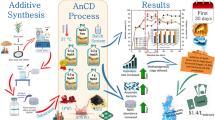Abstract
Strengthened biodegradation is one of the key means to treat surfactant pollution in environment, and microorganism and surfactant have significant effects on degradation. In this paper, co-degradation of CTAB, Triton X-100, SDS and rhamnolipid with glucose by Pseudomonas aeruginosa, Bacillus subtilis and compost microorganisms in liquid culture media, as well as the degradation of rhamnolipid in compost were investigated. The results showed that CTAB was recalcitrant to degrade by the three microorganisms and it also inhibited microorganisms from utilizing readily degradable carbon source. Non-ionic surfactant Triton X-100 could also hardly be degraded, but it was not toxic to microorganisms and would not inhibit the growth of the microorganisms. Anion surfactant SDS had no toxicity to microorganisms and could be co-degraded as carbon source with glucose. Biosurfactant rhamnolipid was a kind of particular surfactant, which had no toxicity and could be degraded by Bacillus subtilis and compost microorganisms, while it could not be utilized by its producing bacterium Pseudomonas aeruginosa. Among these three bacteria, the compost consortium had the strongest degradation capacity on the tested surfactants due to their microorganisms’ diversity. In compost matrix rhamnolipid could be degraded during composting, but not preferentially utilized.
Similar content being viewed by others
Reference
Abd-allah AMA, Srorr T (1998) Biodegradation of anion surfactants in the presence of organic contaminants. Water Res 32(3):944–947
Ahimoua F, Jacquesb P, Deleua M (2000) Surfactin and iturin A effects on Bacillus subtilis surface hydrophobicity. Enzyme Microb Technol 27:749–754
Al-Tahhan RA, Sandrin TR, Bodour AA et al (2000) Rhamnolipid-induced removal of lipopolysaccharide from Pseudomonas aeruginosa: effect on cell surface properties and interaction with hydrophobic substrates. Appl. Environ Microbiol 66:3262–3268
Arino S, Marchal R, Vandecasteele JP (1996). Identification and production of a rhamnolipidic biosurfactant by a Pseudomonas species. Appl Microbiol Biotechnol 45:162–168
Battersby NS, Wilson V (1989) Survey of the anaerobic biodegradation potential of organic chemicals in digesting sludge. Appl Environ Microbiol 55:433–439
Chen HJ, Tseng DH, Huang SL (2005) Biodegradation of octylphenol polyethoxylate surfactant riton X-100 by selected microorganisms. Bioresour Technol 96:1483–1491
Games LM, King JE, Larson RJ (1982) Fate and distribution of a quaternary ammonium surfactant, octadecyltrimethylammonium chloride (OTAC) in wastewater treatment. Environ Sci Technol 16:483–488
García MT, Ribosa I, Guindulain T, SaÂnchez-Leal J, Vives-Rego J (2001) Fate and effect of monoalkyl quaternary ammonium surfactants in the aquatic environment. Environ Pollut 111:169–175
Janicke W, Hilge G (1979) Biodegradability of anionic/cationic surfactant complexes under aerobic and anaerobic conditions of waste water and sludge treatment. Tenside Surfact Det 16: 472–482
Krzeminski SF, Martin JJ, Brackett CK (1973) The environmental impact of a quaternary ammonium bactericide. Household Pers Prod Ind 10: 22–24
Lee DM, Guckert JB, Ventullo RM, Davidson DH, Belanger SE (1997) Stream periphytic biodegradation of the anionic surfactant C12-alkyl sulfate at environmentally relevant concentrations. Ecotoxicol Environ safe 36: 288–296
Margesin R, Schinner F (1998) Biodegradation of the anionic surfactant sodium dodecyl sulfate at low temperatures. Int Biodeter Biodegr 41:139–143
Mezzanotte V, Castiglioni F, Todeschini R, Pavan M (2003) Study on anaerobic and aerobic degradation of different non-ionic surfactants. Bioresour Technol 87:87–91
Monticone V, Mannebach M H, Treiner C (1994) Coadsorption of 2-naphtol and cetylpyridinium chloride at a silica-water interface in relation with the micellar solubilization effect. Langmuir 10:2395–2398
Mulligan CN, Yong RN, Gibbs BF (2001) Surfactant-enhanced remediation of contaminated soil: a review. Eng Geol 60: 371–380
Nicholas LA, Raymond AM (1999) Surfactant applications. Curr Opin Colloid Interface Sci 4:323–324
Noordman WH, Brusseau ML, Janssen DB (2000a) Adsorption of a multicomponent rhamnolipid surfactant to soil. Environ Sci Technol 34:832–838
Pooja S, Swaranjit SC (2004) Potential applications of microbial surfactants in biomedical sciences. Trend Biotechnol 22(3):142–145
Poremba K, Gunkel W, Lang S (1991) Marine biosurfactants III Toxicity testing with marine microorganisms and comparison with synthetic surfactants. Zeit Naturforsch 46:210–216
Providenti MA, Flemming CA, Lee H, Trevors JT (1995) Effect of addition of rhamnolipid biosurfactants of rhamnolipid-producing Pseudomonas aeruginosa on phenanthrene mineralization in soil slurries. FEMS Microbiol Ecol 17:15–26
Sim L, Ward OP, Li ZY (1997) Production and characterization of a biosurfactant isolated from Pseudomonas aeruginosa. UW-1 19:232–238
Scott MJ, Jones MN (2000) The biodegradation of surfactants in the environment. Biochimica et Biophysica Acta 1508:235–251
Van Ginkel CG (1995) Biodegradability of cationic surfactants. In: Karsa DR, Porter MR (Eds) Biodegradability of surfactants. Blackie Academic and Professional, London, pp 183–203
Vipulanandan C, Ren XP (2000) Enhanced solubility and biodegradation of naphthalene with biosurfactant. J Environ Eng July:629–634
Zhang L, Somasundaran P, Singh SK (2004) Synthesis and interfacial properties of sophorolipid derivatives. Colloid Surface 240: 75–82
Zhong H, Zeng GM, Huang GH, Yuan XZ, Fu HY, Shi JG (2003). Effect of rhamnolipid broth on vegetable substrate biodegradation process. In: Zeng GM, Huang GH et al (eds) Energy & environment-a world of challenges and opportunities. Proceedings of the enerenv’ 2003 conference, Changsha, China. Science press, Beijing & New York, pp 841–848
Acknowledgements
The study was financially supported by the National 863 High Technologies Research Foundation of China (No.2004AA649370), the National Basic Research Program (973 Program) (No. 2005CB724203), the Natural Foundation for Distinguished Young Scholars (No.50425927, No.50225926), the Doctoral Foundation of Ministry of Education of China, the Teaching and Research Award Program for Outstanding Young Teachers in Higher Education Institutions of MOE, P.R.C. (TRAPOYT) in 2000.
Author information
Authors and Affiliations
Corresponding author
Rights and permissions
About this article
Cite this article
Zeng, G., Fu, H., Zhong, H. et al. Co-degradation with glucose of four surfactants, CTAB, Triton X-100, SDS and Rhamnolipid, in liquid culture media and compost matrix. Biodegradation 18, 303–310 (2007). https://doi.org/10.1007/s10532-006-9064-8
Received:
Accepted:
Published:
Issue Date:
DOI: https://doi.org/10.1007/s10532-006-9064-8




